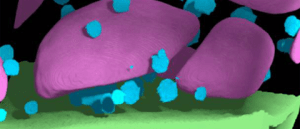Magnetic tweezers reveal NIHCOLE DNA repair mechanism

Scientists used magnetic tweezers to reveal how the RNA molecule ‘NIHCOLE’ repairs cell damage, hindering cancer treatments such as radiotherapy.
In February 2022, then UK Secretary of State for Health and Social Care Sajid Javid declared war on cancer during a speech for World Cancer Day. This came a decade after President Obama’s declaration of war on cancer in 2009, and before him, President Nixon in 1971. It is all very well to declare war on – contextually – abstract concepts as a signifier of proactive political potency, but history continues to illustrate that war is an easy enough thing to declare and a harder thing to fight.
If you want to defeat an enemy, one strategy you can adopt is simply to apply blunt overwhelming force. Radiotherapy and chemotherapy are ways that scientists seek to inflict enough direct damage to kill the carcinogenic cells. This can be an effective approach in some cases, but what do you do if blunt force isn’t enough?
Hepatocellular carcinoma is the most prevalent form of liver cancer, predicted to impact 41,210 new people, and kill 29,380 in 2023 in the USA alone, according to the American Cancer Society. A few years ago, a research team at the University of Navarra (Spain) found that around half of hepatocellular carcinoma patients produce an RNA molecule dubbed ‘NIHCOLE’. This molecule is found in the most aggressive tumors, which are commonly associated with poor prognosis.
When sequencing the human genome two decades ago, NIHCOLE was written off as ‘junk DNA’ because it is a protein synthesized by an RNA molecule and not a gene.
Óscar Llorca, one of the corresponding authors of the study, elaborated: “One of the central dogmas of biology is that the information contained in each gene, in DNA, is translated into proteins. So scientists were stunned when they discovered that only 2% of our DNA contained genes; what was the rest of our genome for? It is unthinkable that 98% of the genome is junk, useless DNA. In the last decade it has been shown that part of this dark genome produces very long RNA molecules, some of which have a prevalent function in cancer.”
 Grant awarded to create training materials for volume electron microscopy
Grant awarded to create training materials for volume electron microscopy
The Chan Zuckerberg Initiative have awarded a team of scientists a grant to create outreach materials and training videos for volume EM.
Previously, the research group concluded that NIHCOLE can repair broken DNA at such an effective rate that it hinders cancer treatments, including radiotherapy. They did not understand the mechanism through which NIHCOLE was repairing cells. In this study, the researchers used magnetic tweezers to study the mechanism, which could lead to novel therapeutic strategies that will make cancer treatments more effective.
Magnetic tweezers are a nanotechnological technique that measure the physical properties of individual molecules. First, a magnetic bead, which is a nanometer in scale, is attached to one end of a DNA strand and then nano-magnetic tweezers are used to pull on it. The length that the molecule stretches to reveals whether the molecule is broken or has been repaired.
Using this method, the study found that NIHCOLE builds bridges by taking the frayed ends of broken DNA and joining the cellular fragments together.
So, you’ve declared war, but the aggressive liver cancer has this unnerving terminatoresque self-repairing capability and you can’t damage the cells enough? As we’re all well aware, you can’t just apply ever-increasing amounts of radiation to living creatures. They don’t respond well. What now?
If the NIHCOLE molecule has efficiently repaired DNA, malignant cell proliferation goes on relatively uninterrupted, regardless of accreting DNA damage from radiotherapy or chemotherapy. The researchers of this study propose that inhibiting NIHCOLE with drugs that block or distort the protein structure could make it easier to eradicate tumors.
It is important to moderate expectations when talking about advances against cancer. While all advancements are good news, this one alone, however significant, will almost certainly not be the crucial tool that wins the proverbial war – no matter the well-intentioned exhortations of the Nixons, Obamas and Javids of the world, to say nothing of the millions around the world impacted by the disease. But it might be enough to turn the tide of one battle, and if you can win enough battles…. who knows?